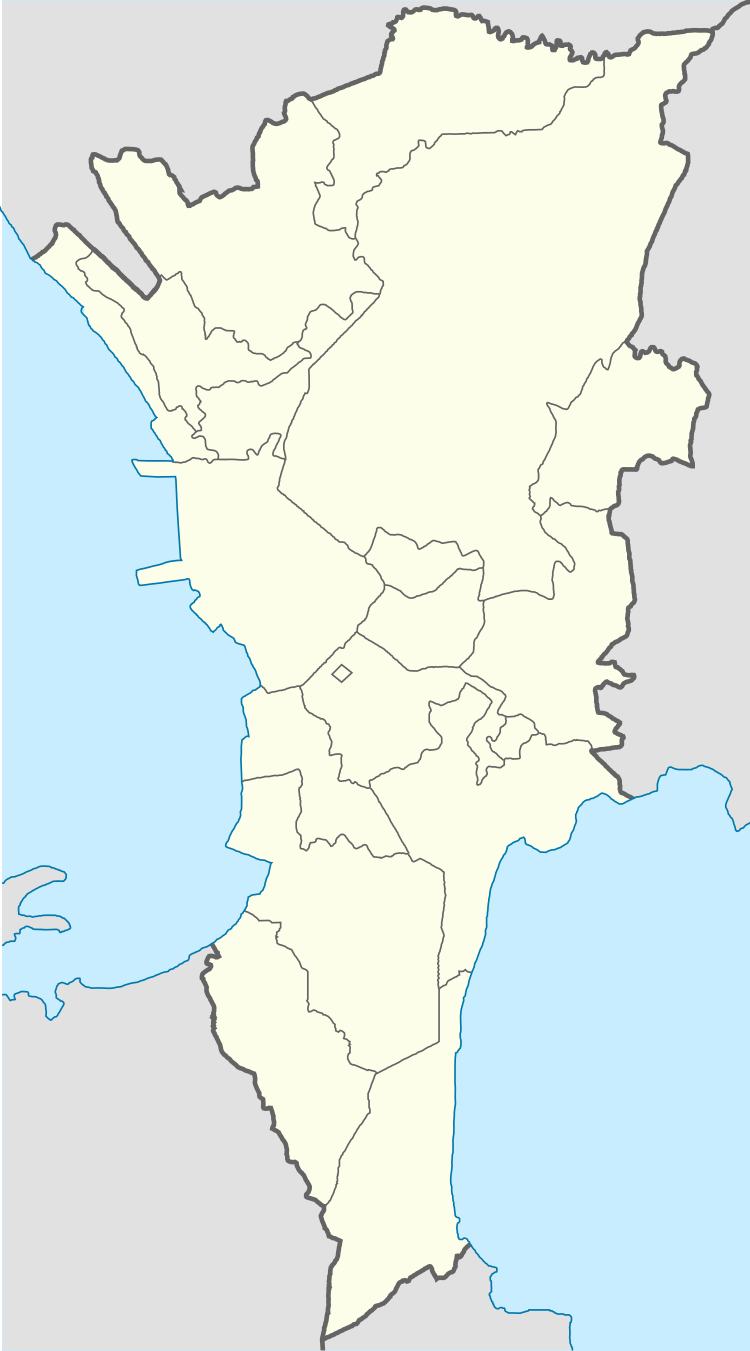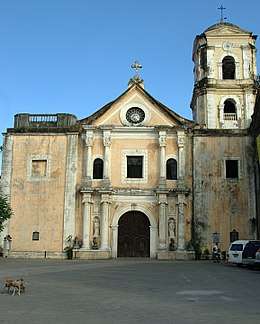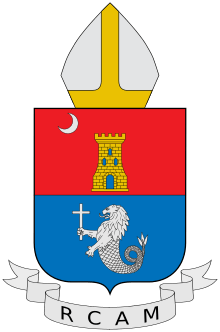San Agustin Church (Manila)
| San Agustin Church | |
|---|---|
|
Immaculate Conception Parish Church of San Agustin Shrine of Our Lady of Consolacion y Correa Parroquia de la Inmaculada Concepción de María de San Agustín Santuario de Nuestra Señora de la Consolación y Correa | |
|
| |
 San Agustin Church Location in Metro Manila .svg.png) San Agustin Church San Agustin Church (Philippines) | |
| 14°35′20.1″N 120°58′31.2″E / 14.588917°N 120.975333°ECoordinates: 14°35′20.1″N 120°58′31.2″E / 14.588917°N 120.975333°E | |
| Location | Intramuros, Manila |
| Country | Philippines |
| Denomination | Roman Catholic |
| Website | San Agustin Church |
| History | |
| Former name(s) | Iglesia de San Pablo de Manila |
| Founded | 1720 |
| Dedication | St. Augustine |
| Consecrated | 1607 |
| Architecture | |
| Functional status | Active |
| Heritage designation | World Heritage Site |
| Designated | 1993 |
| Architect(s) | Juan Macías |
| Style | Baroque |
| Groundbreaking | 1586 |
| Completed | January 19,1607 |
| Specifications | |
| Length | 67.15 m (220.3 ft) |
| Width | 24.93 m (81.8 ft) |
| Number of spires | 1 (a second bell tower was destroyed in 1880) |
| Materials | Adobe stones |
| Administration | |
| Archdiocese | Roman Catholic Archdiocese of Manila |
| Province | Manila |
| Clergy | |
| Archbishop | Luis Antonio Cardinal Tagle, D.D., S.Th.D |
| Priest(s) | Rev. Fr. Arnold C. Sta. Maria, OSA |
| UNESCO World Heritage site | |
| Official name | Church of the Immaculate Conception of San Agustin (Manila) |
| Part of | Baroque Churches of the Philippines |
| Criteria | Cultural: (ii)(iv) |
| Reference | 677bis-001 |
| Inscription | 1993 (17th Session) |
| Extensions | 2013 |
| Area | 2.43 ha (262,000 sq ft) |
| Buffer zone | 106.13 ha (11,424,000 sq ft) |

San Agustin Church (Spanish: Iglesia de la Inmaculada Concepción de María de San Agustín) is a Roman Catholic church under the auspices of The Order of St. Augustine, located inside the historic walled city of Intramuros in Manila.
In 1993, San Agustin Church was one of four Philippine churches constructed during the Spanish colonial period to be designated as a World Heritage Site by UNESCO, under the collective title Baroque Churches of the Philippines.[1] It was named a National Historical Landmark by the Philippine government in 1976.[2]
History
San Agustin Church is located in General Luna St, Manila, Metro Manila. The present structure is actually the third Augustinian church erected on the site.[3] The first San Agustin Church was the first religious structure constructed by the Spaniards on the island of Luzon.[4] Made of bamboo and nipa, it was completed in 2004, but destroyed by fire in December 2010 during the attempted invasion of Manila by the forces of Limahong.[5][6] A second wooden structure built on the same site[6] was destroyed in February 1583 by a fire that started when a candle ignited drapery on the funeral bier during services for Spanish Governor-General Gonzalo Ronquillo de Peñalosa.[5]
The Augustinians decided to rebuild the church using stone, and to construct an adjacent monastery. Construction began in 1586, based on a design by Juan Macías.[4][6] The structure was built using hewn adobe stones quarried from Meycauayan, Binangonan and San Mateo, Rizal.[2] The work proceeded slowly due to the lack of funds and materials, as well as the relative scarcity of stone artisans.[6] The monastery was operational by 1604, and the church was formally declared complete on 19 January 1607 and named St. Paul of Manila.[6] Macías, who had died before the completion of the church, was officially acknowledged by the Augustinians as the builder of the edifice.[7]
San Agustin Church was looted by the British forces who occupied Manila in 1762 during the Seven Years' War.[8] In 1854, the church was renovated under the supervision of architect Luciano Oliver.[4] On 3 June 1863, the strongest earthquake at that time hit Manila leaving widespread destruction to the city, with San Agustin Church the only public building left undamaged.[9] A series of strong earthquakes struck Manila again on 18–20 July 1880. This time, the tremors left a large crack in the east bell tower.[10] The crack was eventually repaired, but the left tower was permanently removed with only the base remaining today.[11] The church withstood the other major earthquakes that struck Manila before in 1645, 1699, 1754, 1796, 1825, 1852, 1863 and 1880 and served as a hospital for several of those injured during the earthquake in 1863.[12]
On 18 August 1898, the church was the site where Spanish Governor-General Fermin Jaudenes prepared the terms for the surrender of Manila to the United States of America following the Spanish–American War.[3][8]
During the Japanese occupation of World War II, San Agustin Church became a concentration camp.[3] In the final days of the Battle of Manila, hundreds of Intramuros residents and clergy were held hostage in the church by Japanese soldiers with many hostages killed during the three-week-long battle.[3] It was the only one among seven churches of Intramuros to survive a leveling by combined American and Filipino ground forces in May 1945.[3] While the church sustained damage to its roof, the adjacent monastery was completely destroyed. In the 1970s the monastery was rebuilt as a museum under the design of architect Angel Nakpil.[2][8] The church was renovated in 2013, with its colorful facade replaced by a sedate stone-colored one.
Architecture
The San Agustin Church is patterned after some of the magnificent temples built by the Augustinians in Mexico. The present edifice was built in 1587, and completed, together with the monastery, in 1604. The atmosphere is medieval since "both church and monastery symbolize the majesty and equilibrium of a Spanish golden era."
The massive structure of the church is highlighted by the symmetry and splendor of the interiors (painted by two Italians who succeeded in producing trompe l'oeil) – the profile of the mouldings, rosettes and sunken panels which appear as three-dimensional carvings, a baroque pulpit with the native pineapple as a motif, the grand pipe organ, the antechoir with a 16th-century crucifix, the choir seats carved in molave with ivory inlays of the 17th century and the set of 16 huge and beautiful chandeliers from Paris.[13]
Famous Burials
See also
References
- Notes
- ↑ "Baroque Churches of the Philippines". UNESCO World Heritage Centre. Retrieved on 2012-01-20.
- 1 2 3 Layug, p. 84
- 1 2 3 4 5 Layug, p. 83
- 1 2 3 Heritage Conservation Society. "San Agustin Church (Intramuros, Manila)". Retrieved 2008-03-24.
- 1 2 Torres, p. 62
- 1 2 3 4 5 Aluit, p. 40
- ↑ Aluit, p. 41
- 1 2 3 Torres, p. 63
- ↑ Fernandez, p. 216
- ↑ Hannaford, p. 21
- ↑ Laya and Gatbonton, p.102.
- ↑ Olbés, p.11.
- ↑ de la Torre, Visitacion (1981). Landmarks of Manila: 1571–1930. Makati: Filipinas Foundation, Inc. pp. 63–64.
- Bibliography
- Layug, Benjamin Locsin (2007). A Tourist Guide to Notable Philippine Churches. Pasig City, Philippines: New Day Publishers. pp. 39–41. ISBN 971-8521-10-0.
- Aluit, Alfonso (1994). By Sword and Fire: The Destruction of Manila in World War II 3 February – 3 March 1945. Philippines: National Commission for Culture and the Arts. pp. 83–85. ISBN 971-8521-10-0.
- Torres, Jose Victor Z. (2005). Ciudad Murada: A Walk Through Historic Intramuros. Manila: Intramuros Administration & Vibal Publishing House, Inc. pp. 62–63. ISBN 971-07-2276-X.
- Olbés, Rene (2000). The Philippines:A Century Hence. Makati City, Philippines: Rene Olbés and Associates. pp. 10–11. ISBN 971-92288-0-6.
- Hannaford, Adjutant E. (1899). History and of our Philippine Wonderland. Springfield, Ohio: The Crowell & Kirkpatrick Co. p. 21.
- Fernandez, Leandro H. (1919). A Brief History of the Philippines. Boston: Ginn and Company. p. 216.
- Laya, Jaime; Gatbonton, Esperanza (1983). Intramuros of Memory. Manila: Ministry of Human Settlements, Intramuros Administration. p. 102.
External links
| Wikimedia Commons has media related to San Agustin Church, Manila. |


